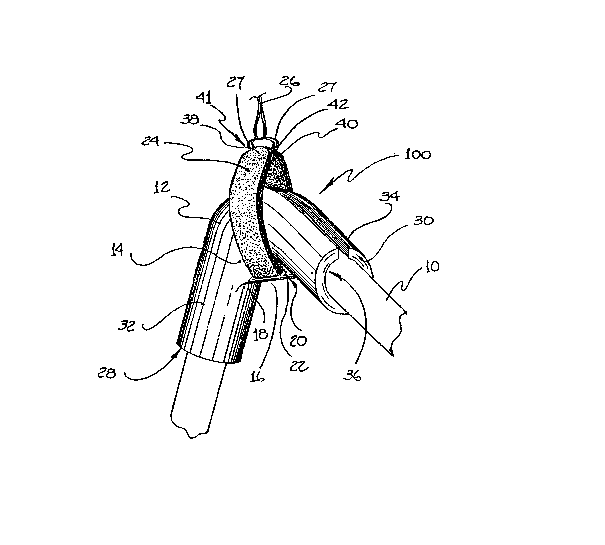Une partie des informations de ce site Web a été fournie par des sources externes. Le gouvernement du Canada n'assume aucune responsabilité concernant la précision, l'actualité ou la fiabilité des informations fournies par les sources externes. Les utilisateurs qui désirent employer cette information devraient consulter directement la source des informations. Le contenu fourni par les sources externes n'est pas assujetti aux exigences sur les langues officielles, la protection des renseignements personnels et l'accessibilité.
L'apparition de différences dans le texte et l'image des Revendications et de l'Abrégé dépend du moment auquel le document est publié. Les textes des Revendications et de l'Abrégé sont affichés :
| (12) Brevet: | (11) CA 1277302 |
|---|---|
| (21) Numéro de la demande: | 1277302 |
| (54) Titre français: | SUPPORT POUR TUYAU SOUPLE ET CABLE |
| (54) Titre anglais: | HOSE AND CABLE SUPPORT |
| Statut: | Durée expirée - après l'octroi |
| (51) Classification internationale des brevets (CIB): |
|
|---|---|
| (72) Inventeurs : |
|
| (73) Titulaires : |
|
| (71) Demandeurs : |
|
| (74) Agent: | MLT AIKINS LLP |
| (74) Co-agent: | |
| (45) Délivré: | 1990-12-04 |
| (22) Date de dépôt: | 1989-01-30 |
| Licence disponible: | S.O. |
| Cédé au domaine public: | S.O. |
| (25) Langue des documents déposés: | Anglais |
| Traité de coopération en matière de brevets (PCT): | Non |
|---|
| (30) Données de priorité de la demande: | S.O. |
|---|
ABSTRACT
An apparatus for suspending hoses or cables which consists
of an elongate support having a support surface in the shape of
an arch with a vertex, depending haunches and intrados. A hose
or cable may be supported upon the vertex and haunches of the
arch. At least one strap is secured transversely to the support.
Loops or rings are provided for attaching the strap to a
suspension line. The invention provides a simple and thus
inexpensive support while minimizing the risk of damage to the
hose due to crimping or to the supporting strap due to a rough
surface of the supported article.
Note : Les revendications sont présentées dans la langue officielle dans laquelle elles ont été soumises.
Note : Les descriptions sont présentées dans la langue officielle dans laquelle elles ont été soumises.

2024-08-01 : Dans le cadre de la transition vers les Brevets de nouvelle génération (BNG), la base de données sur les brevets canadiens (BDBC) contient désormais un Historique d'événement plus détaillé, qui reproduit le Journal des événements de notre nouvelle solution interne.
Veuillez noter que les événements débutant par « Inactive : » se réfèrent à des événements qui ne sont plus utilisés dans notre nouvelle solution interne.
Pour une meilleure compréhension de l'état de la demande ou brevet qui figure sur cette page, la rubrique Mise en garde , et les descriptions de Brevet , Historique d'événement , Taxes périodiques et Historique des paiements devraient être consultées.
| Description | Date |
|---|---|
| Inactive : Périmé (brevet sous l'ancienne loi) date de péremption possible la plus tardive | 2009-01-30 |
| Lettre envoyée | 2006-12-27 |
| Lettre envoyée | 2006-11-09 |
| Inactive : Lettre officielle | 2006-10-26 |
| Inactive : CIB de MCD | 2006-03-11 |
| Inactive : Lettre officielle | 2002-10-18 |
| Exigences relatives à la nomination d'un agent - jugée conforme | 2002-10-18 |
| Exigences relatives à la révocation de la nomination d'un agent - jugée conforme | 2002-10-18 |
| Inactive : Lettre officielle | 2002-10-18 |
| Inactive : Lettre officielle | 2002-10-18 |
| Inactive : Grandeur de l'entité changée | 2001-12-14 |
| Inactive : CIB en 1re position | 1999-03-08 |
| Inactive : CIB attribuée | 1999-03-08 |
| Accordé par délivrance | 1990-12-04 |
Il n'y a pas d'historique d'abandonnement
| Type de taxes | Anniversaire | Échéance | Date payée |
|---|---|---|---|
| TM (catégorie 1, 7e anniv.) - petite | 1997-12-04 | 1997-08-11 | |
| TM (catégorie 1, 8e anniv.) - petite | 1998-12-04 | 1998-11-02 | |
| TM (catégorie 1, 9e anniv.) - petite | 1999-12-06 | 1999-11-10 | |
| TM (catégorie 1, 10e anniv.) - petite | 2000-12-04 | 2000-11-16 | |
| TM (catégorie 1, 11e anniv.) - petite | 2001-12-04 | 2001-11-28 | |
| TM (catégorie 1, 12e anniv.) - petite | 2002-12-04 | 2002-10-11 | |
| TM (catégorie 1, 14e anniv.) - petite | 2004-12-06 | 2002-10-11 | |
| TM (catégorie 1, 13e anniv.) - petite | 2003-12-04 | 2002-10-11 | |
| TM (catégorie 1, 15e anniv.) - petite | 2005-12-05 | 2002-10-11 | |
| TM (catégorie 1, 16e anniv.) - petite | 2006-12-04 | 2006-09-25 | |
| Enregistrement d'un document | 2006-10-17 |
Les titulaires actuels et antérieures au dossier sont affichés en ordre alphabétique.
| Titulaires actuels au dossier |
|---|
| ICECAP EQUITY CORP. |
| Titulaires antérieures au dossier |
|---|
| DANIEL PHILLIP HORVATH |